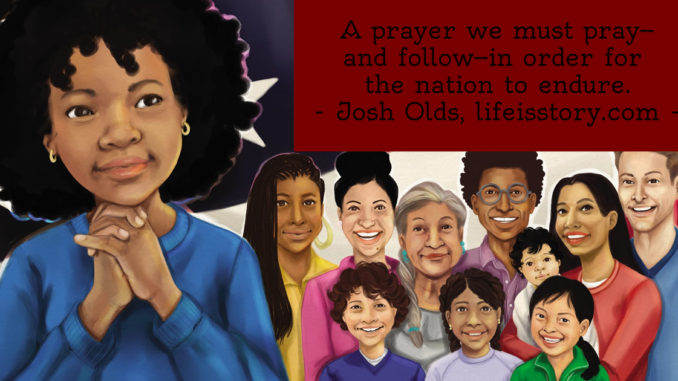
There is never a bad time to pray for your country but, especially now—with the partisanship and vitriol, with increasing polarization and decreasing civility, with the cold culture war rising to the brink of a boil—we need to pray for the United States. In the early morning hours of January 7, 2021, in the wake of an attempted insurrection that sent Congress into hiding, Senate Chaplain Barry Black closed out the session of Congress with a call to unity.
That prayer led to A Prayer for Our Country, published by Zonderkidz. Aimed at ages 4-8, the book is a written prayer meant to teach readers how to pray and specifically, how to pray for one’s country. Loosely following the structure of the Lord’s Prayer, Dr. Black begins by praising God and acknowledging God’s greatness. He then moves to a posture of thankfulness for the blessings that God has given us. He highlights the wonders of creation, the provision of clothes, food, and shelter. Then he moves to praying the God would use to be the answer to the prayer, that we would be able to help others. Teach us to use words wisely. Remind us that harsh words hurt, while kind words heal. As the prayer closes, Black admits that we face big problems—but we have behind us an even bigger God.
Every word of the prayer is carefully chosen, evidencing Chaplain Black’s long tenure in a position that requires one to understand Christianity in all its faith traditions. It is non-denominational and non-partisan, a refreshing change from so many nationalistic prayers I’ve heard over the past several years. Black concludes: Show us how to live so that this country may be a better place, and help us to do our best whether there is anyone to see it or not. It’s a statement that holds both national pride and makes it subservient to the worship of God.
Kim Holt’s illustrations offer a diverse and colorful backdrop to the prayer, showing America in all its colors, shapes, and forms. Some of the facial features don’t look quite right to me—something in the nose and mouth, in particular, that just doesn’t look lifelike. But that’s my only criticism of the book. The goal was, I’m sure, for kids to see themselves in this book and I think that is largely accomplished.
As a nation and as a church, we have work to do. As I read this book, I read it as though I was a child—tried to consider it through their mindset. But I also read it as an adult and tried to consider how I’d interpret this prayer as a pastor or a politician. And the prayer is just as relevant and applicable to either group. It’s a thoughtful work, borne out of a need for the next generation to do better. It is a prayer we must pray—and follow—in order for the nation to endure.
